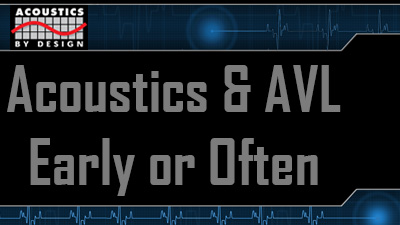When the first call or email comes in about a new project it’s important to ask if the project is for renovating an existing space, or new construction. It’s an important question because the approach to each type of project is different. We’re brought in after a space is occupied about as frequently as when a project is nothing but drawings.
It’s all too common though to hear something like this, “We’ve been in the space for a while, and we just can’t stand it anymore.” It’s equally common to hear a seasoned architect or builder say, “The project is almost done, and now we need to do something about the acoustics and AVL.” So, when is the right time to start working with an independent acoustical consultant, or AVL designer? A good rule of thumb is, “Early, or Often.”
Before or After Construction?
Of course acoustical and AVL design can be added during or after construction, we work that way all the time. However, once a structure is in the building process, or already built there’s more work, and usually more construction to be done. It’s up to you, whether you want to bring us in early, or invite us to help out often, later on.
Part of the Process
For the Audio-Video and Specialty Lighting systems, our designers work with you to help you establish a budget for your project, and then design to that budget. Their designs include line drawings of conduit locations, racks and other equipment placements, not to mention all the power requirements for your electrical contractor, and specifications for the installation contractor. When we’re brought in early, all of those locations can be incorporated into the overall design, and bid-packs for construction. Afterwards, there’s the prospect of cutting concrete, and opening walls and ceilings, in order to get things in place. Sometimes this is necessary, especially when the project is phased in over several years. If we help you with your eventual design initially, we can make it easier to implement second and third phases later.
A phased approach is often the case with acoustics. Budgetary concerns can make putting acoustics off until later seem like the right thing to do. Though, if you consider how the room acoustics can be achieved through the size and shape of the room, along with treatment materials it makes sense to get the room right, and add subtle treatments. Mechanical noise and building systems noise can be a concern in healthcare, university and K-12 education, corporate, residential, mixed-use, worship, and performance settings. During design, we can provide recommendations for placement and routing of mechanical systems to control noise and vibration. After construction, we can provide recommendations for noise and vibration control systems. Those recommendations can be difficult to implement, as they can involve lifting or moving existing (and potentially heavy) equipment. A desired level of privacy for offices, conference rooms, and residences, or levels required by HIPAA and FGI Guidelines for healthcare, can be achieved through noise isolation, and sound masking techniques. Our approach to sound transmission also depends on where you are in your process. In short, if the spaces are already in place, we usually need to perform acoustical measurements to determine the current conditions. When a structure hasn’t been built yet, we can make our recommendations based on architectural drawings, and help on-site with construction methods as the project moves forward.
Sound System instead of Acoustics?
It’s also good to remember that even the best electronics can’t fix bad acoustics. When a space has both AVL design and Acoustical needs, it makes sense to work with an independent consulting company, like Acoustics By Design, who can do both, and integrate the two connected activities with each other. As you bring us into your renovation or construction project process, either before, during, or after, we’re able to help you with unbiased recommendations to get the best results. We’re happy to help, early, or often.

I am building two sound walls in a one story multi tenant commercial building, in an effort to eliminate the noise transmission to the neighbors on either side of my music studio. There is a 2×4 drop type accoustic ceiling throughout. Will it be advisable or necessary to do someting above the ceiling to mitigate the sound?
It’s important that the walls go all the way up to the structure, and not just up to the drop-ceiling. There are also dozens of details to help protect your neighbors from the sound you’re creating, as well as protect your studio from sounds generated by the neighbors. An independent acoustical consultant can perform testing in the spaces to help determine the current performance of the walls, floor-ceilings, and the rest of the structure, or in some cases work directly from architectural drawings to make mitigation recommendations.